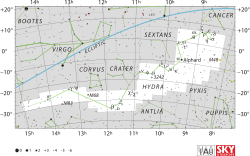Zeta Hydrae

Location of ζ Hydrae (circled) near the center | |
| Observation data Epoch J2000.0 Equinox J2000.0 | |
|---|---|
| Constellation | Hydra |
| Right ascension | 08h 55m 23.62614s[1] |
| Declination | +05° 56′ 44.0354″[1] |
| Apparent magnitude (V) | 3.10[2] |
| Characteristics | |
| Spectral type | G9 II-III[3] (G9II-I;OtH[4]) |
| U−B color index | +0.82[2] |
| B−V color index | +1.00[2] |
| Astrometry | |
| Radial velocity (Rv) | +22.8[5] km/s |
| Proper motion (μ) | RA: –100.06[1] mas/yr Dec.: +15.46[1] mas/yr |
| Parallax (π) | 19.51 ± 0.18[1] mas |
| Distance | 167 ± 2 ly (51.3 ± 0.5 pc) |
| Absolute magnitude (MV) | –0.24[6] |
| Details | |
| Mass | 4.2[7] M☉ |
| Radius | 17.9[8] R☉ |
| Luminosity | 132[8] L☉ |
| Surface gravity (log g) | 2.48[8] cgs |
| Temperature | 4,925[7] K |
| Metallicity [Fe/H] | –0.21[9] dex |
| Rotational velocity (v sin i) | 2.5[9] km/s |
| Age | 400[6] Myr |
| Other designations | |
Zeta Hydrae (ζ Hya, ζ Hydrae) is a solitary star in the equatorial constellation of Hydra. This is a generally faint constellation, so, at an apparent visual magnitude of +3.10,[2] this is the third brightest member after Alphard and Gamma Hydrae. The distance to this star has been measured using the parallax technique, yielding a value of roughly 167 light-years (51 parsecs).[1] At this distance, the visual magnitude of the star is diminished by 0.03 as a result of extinction from intervening gas and dust.[6] The star Delta Hydrae is located 12.9 light-years (4.0 parsecs) from Zeta Hydrae and may be a co-moving companion.[4]
With a stellar classification of G9 II-III,[3] this is an evolved giant star that is radiating 132[8] times the luminosity of the Sun from its outer envelope at an effective temperature of 4,925 K.[7] At this heat, the star glows with the yellow hue of a G-type star.[11] The radius of this star, as measured using interferometry, is about 18 times the Sun's radius.[8] It has an estimated 4.2 times the mass of the Sun[7] and is around 400 million years old.[6]
Name and etymology
This star, along with δ Hya (Lisan al Sudja), ε Hya, η Hya, ρ Hya and σ Hya (Minhar al Shija), were Ulug Beg's Min al Azʽal, "Belonging to the Uninhabited Spot".[12] According to the catalogue of stars in the Technical Memorandum 33-507 - A Reduced Star Catalog Containing 537 Named Stars, Min al Azʽal or Minazal were the title for five stars:δ Hya as Minazal I, η Hya as Minazal II, ε Hya as Minazal III, ρ Hya as Minazal IV and ζ Hya as Minazal V (exclude σ Hya).[13]
In Chinese, 柳宿 (Liǔ Sù), meaning Willow, refers to an asterism consisting of ζ Hydrae, δ Hydra, σ Hydrae, η Hydrae, ρ Hydrae, ε Hydrae, ω Hydrae and θ Hydrae[14] Consequently, ζ Hydrae itself is known as 柳宿六 (Liǔ Sù liù, English: the Sixth Star of Willow).[15]
The people of Groote Eylandt called Unwala, "The Crab", for the star cluster including this star, δ Hya (Lisan al Sudja), ε Hya, η Hya, ρ Hya and σ Hya (Minhar al Shija).[16]
References
- ↑ 1.0 1.1 1.2 1.3 1.4 1.5 van Leeuwen, F. (November 2007), "Validation of the new Hipparcos reduction", Astronomy and Astrophysics 474 (2): 653–664, arXiv:0708.1752, Bibcode:2007A&A...474..653V, doi:10.1051/0004-6361:20078357
- ↑ 2.0 2.1 2.2 2.3 Jennens, P. A.; Helfer, H. L. (September 1975), "A new photometric metal abundance and luminosity calibration for field G and K giants.", Monthly Notices of the Royal Astronomical Society 172: 667–679, Bibcode:1975MNRAS.172..667J
- ↑ 3.0 3.1 Morgan, W. W.; Keenan, P. C. (1973), "Spectral Classification", Annual Review of Astronomy and Astrophysics 11 (1): 29, Bibcode:1973ARA&A..11...29M, doi:10.1146/annurev.aa.11.090173.000333
- ↑ 4.0 4.1 Shaya, Ed J.; Olling, Rob P. (January 2011), "Very Wide Binaries and Other Comoving Stellar Companions: A Bayesian Analysis of the Hipparcos Catalogue", The Astrophysical Journal Supplement 192 (1): 2, arXiv:1007.0425, Bibcode:2011ApJS..192....2S, doi:10.1088/0067-0049/192/1/2
- ↑ Wielen, R. et al. (1999), Sixth Catalogue of Fundamental Stars (FK6). Part I. Basic fundamental stars with direct solutions (35), Astronomisches Rechen-Institut Heidelberg, Bibcode:1999VeARI..35....1W
- ↑ 6.0 6.1 6.2 6.3 Takeda, Yoichi; Sato, Bun'ei; Murata, Daisuke (August 2008), "Stellar parameters and elemental abundances of late-G giants", Publications of the Astronomical Society of Japan 60 (4): 781–802, arXiv:0805.2434, Bibcode:2008PASJ...60..781T
- ↑ 7.0 7.1 7.2 7.3 Ando, Hiroyasu et al. (April 2008), "Detection of Small-Amplitude Oscillations in the G-Giant HD76294 (ξ Hydrae)", Publications of the Astronomical Society of Japan 60 (2): 219–222, Bibcode:2008PASJ...60..219A
- ↑ 8.0 8.1 8.2 8.3 8.4 Sato, Bun'ei (August 2010), "Oscillations in G-Type Giants", Publications of the Astronomical Society of Japan 62 (4): 1117–1126, arXiv:1007.1286, Bibcode:2010PASJ...62.1117A
- ↑ 9.0 9.1 Massarotti, Alessandro et al. (January 2008), "Rotational and Radial Velocities for a Sample of 761 HIPPARCOS Giants and the Role of Binarity", The Astronomical Journal 135 (1): 209–231, Bibcode:2008AJ....135..209M, doi:10.1088/0004-6256/135/1/209
- ↑ "zet Hya -- Star", SIMBAD Astronomical Object Database (Centre de Données astronomiques de Strasbourg), retrieved 2006-11-05
- ↑ "The Colour of Stars", Australia Telescope, Outreach and Education (Commonwealth Scientific and Industrial Research Organisation), December 21, 2004, retrieved 2012-01-16
- ↑ Allen, R. H. (1963), Star Names: Their Lore and Meaning (Reprint ed.), New York, NY: Dover Publications Inc, p. 249, ISBN 0-486-21079-0, retrieved 2010-12-12
- ↑ Rhoads, Jack W. (November 15, 1971), Technical Memorandum 33-507-A Reduced Star Catalog Containing 537 Named Stars, Jet Propulsion Laboratory, California Institute of Technology
- ↑ (Chinese) 中國星座神話, written by 陳久金. Published by 台灣書房出版有限公司, 2005, ISBN 978-986-7332-25-7.
- ↑ (Chinese) AEEA (Activities of Exhibition and Education in Astronomy) 天文教育資訊網 2006 年 5 月 28 日
- ↑ Selin, Helaine, ed. (1997), Encyclopaedia of the history of science, technology, and medicine in non-western cultures, Dordrecht: Kluwer Academic Publishers, p. 105
| ||||||||||||||||||||||||||